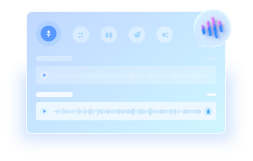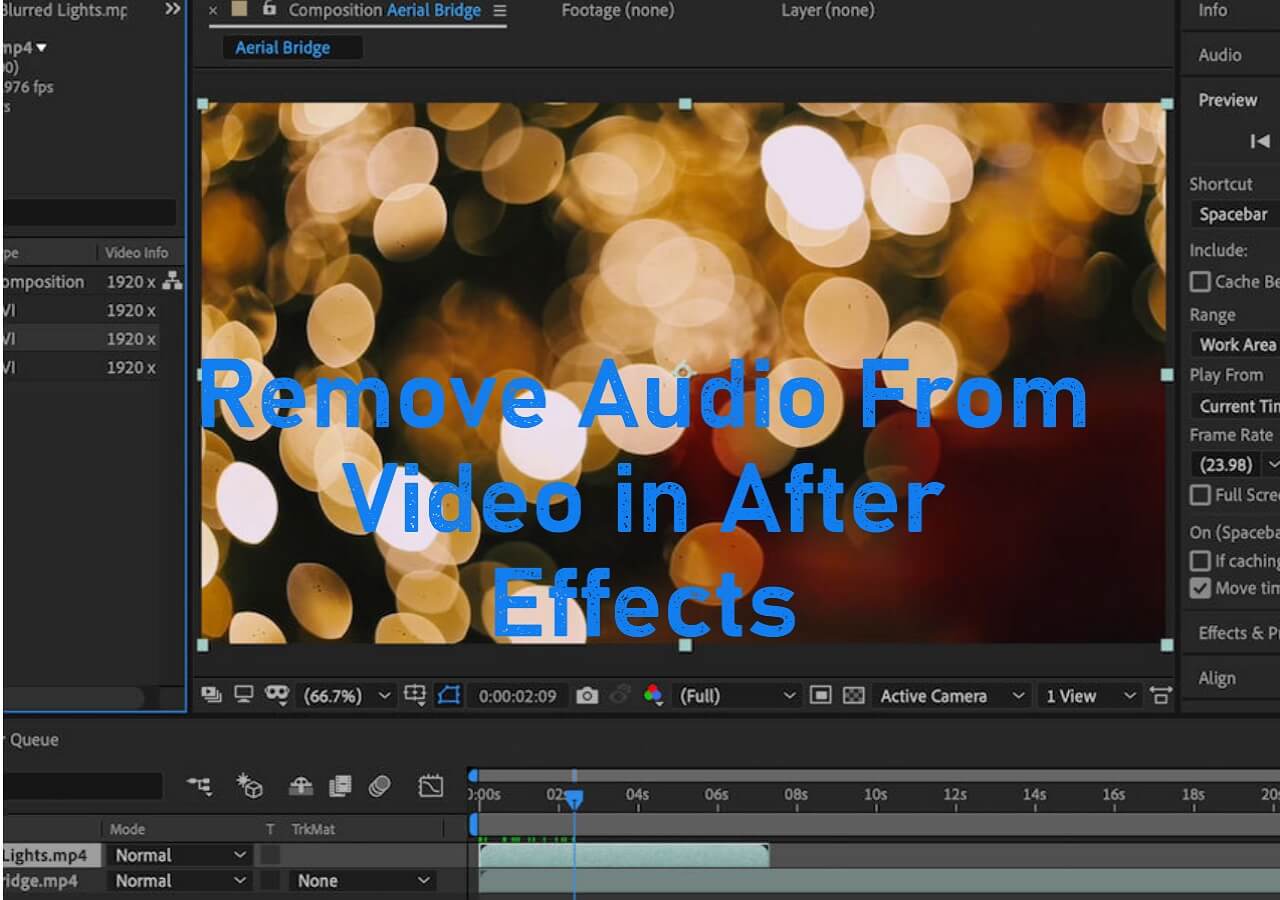-
![]()
Sofia Albert
Sofia has been involved with tech ever since she joined the EaseUS editor team in March 2011 and now she is a senior website editor. She is good at solving various issues, such as video downloading and recording.…Read full bio -
![]()
Alin
Alin is a sophisticated editor for EaseUS in tech blog writing. She is proficient in writing articles related to screen recording, voice changing, and PDF file editing. She also wrote blogs about data recovery, disk partitioning, data backup, etc.…Read full bio -
Jean has been working as a professional website editor for quite a long time. Her articles focus on topics of computer backup, data security tips, data recovery, and disk partitioning. Also, she writes many guides and tutorials on PC hardware & software troubleshooting. She keeps two lovely parrots and likes making vlogs of pets. With experience in video recording and video editing, she starts writing blogs on multimedia topics now.…Read full bio
-
![]()
Gorilla
Gorilla joined EaseUS in 2022. As a smartphone lover, she stays on top of Android unlocking skills and iOS troubleshooting tips. In addition, she also devotes herself to data recovery and transfer issues.…Read full bio -
![]()
Rel
Rel has always maintained a strong curiosity about the computer field and is committed to the research of the most efficient and practical computer problem solutions.…Read full bio -
![]()
Dawn Tang
Dawn Tang is a seasoned professional with a year-long record of crafting informative Backup & Recovery articles. Currently, she's channeling her expertise into the world of video editing software, embodying adaptability and a passion for mastering new digital domains.…Read full bio -
![]()
Sasha
Sasha is a girl who enjoys researching various electronic products and is dedicated to helping readers solve a wide range of technology-related issues. On EaseUS, she excels at providing readers with concise solutions in audio and video editing.…Read full bio
Content
0 Views |
0 min read
Key Takeaways
🎉 To change the pitch of a song in Audacity, load the song to the software and go up to "Effect" > "Pitch and Tempo" > "Change Pitch…," customize the options, review and export the final result.
Musicians and producers adjust pitch to match specific musical keys, while individuals correct errors in recordings or enhance the sound quality of a track. Whether you apply a pitch-changing effect to music, film, or your videos, you need a reliable pitch changer to help with that.
Audacity is an open-source audio editing software that changes the pitch of a song in 3 different ways. This article details how to use Audacity's pitch adjustment tools effectively without compromising audio quality. Also, I'll introduce a simpler, free online YouTube pitch changer to make things easier. Keep reading.
| Audacity Change Pitch𝄞 | Effectiveness💡 |
|---|---|
| Change Pitch | Change the pitch without changing its tempo. |
| Change Speed and Pitch | Change speed, tempo, pitch, and frequency. |
| GSnap VST Plugin | Autotune the pitch of any audio. |
1. Change Pitch: Without Changing the Length
The Change Pitch effect in Audacity seamlessly adjusts the pitch of an audio file while preserving its tempo or speed. This functionality operates by applying precise percentage changes to the existing pitch of a selected audio segment. One can also change the pitch, semitones, or frequency.
However, it may introduce audible distortions, especially in extreme settings. By default, it may alter the length of the selection; you can keep the length by checking "Use high-quality stretching (slow)." Furthermore, pitch detection accuracy diminishes beyond certain frequency thresholds based on the sample rate.
To change the pitch in Audacity over time:
Step 1. Launch Audacity and Upload the File.
Open Audacity on your desktop, and upload the audio file by going to "File" > "Import" > "Audio…" and selecting it from the local library. If it doesn't go with your recording format, install FFmpeg for other file formats. Select the part of the audio you want to edit using the selection tool.
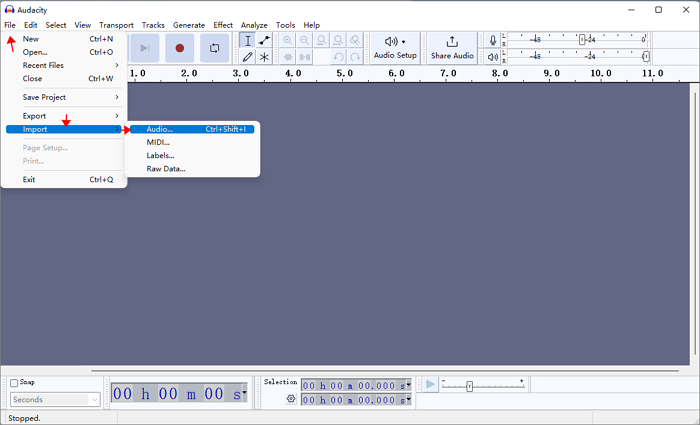
Step 2. Apply the Change Pitch Effect.
Access the effect by "Effect" > "Pitch and Tempo" > "Change Pitch…," and you can see the pop-up window which reads:
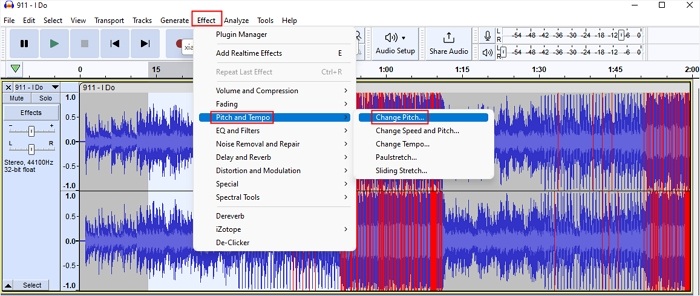
- Estimated Start Pitch: Audacity detects the pitch of the primary note at the selection's outset.
- From and to: Select the musical note from the dropdown and the octave next to it.
- Semitones (half-steps): Enter the value of semitones if you know how many of them could be changed.
- Frequency: Enter the original and desired frequencies in the "from" and "to" boxes respectively, if you know them. Typically, you only need to adjust the "to" box for the desired tone frequency.
- Percent Change: Enter a value or drag the slider to change the pitch by a percent. Other values will be changed accordingly.
- Use high quality stretching (slow): Enabling the checkbox in Change Pitch slows processing but preserves the exact selection length, usually improving quality, especially with percussive music.

Step 3. Preview and Download.
Click on "Preview" to play the modified part, and press "Apply" if you like it. Go up to "File" > "Export Audio" and customize your output options. Then, click "Export."

You can see the video to change the pitch in Audacity🎞️:

2. Change Speed and Pitch: Without Losing Quality
The Change Speed and Pitch effect doesn't apply so much of a change on your audio, so it'd be ideal for mild changes. The effect affects mainly the tempo, pitch, and frequency. Reducing speed lowers all frequencies while increasing speed raises them all.
To change the pitch in Audacity without chipmunk:
Step 1. Select the Audio Portion.
Open Audacity and load your audio file here. Select the part you want to change.
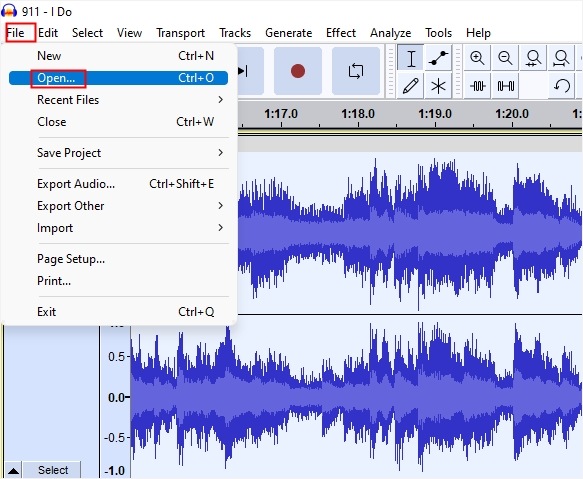
Step 2. Use the Change Speed and Pitch Effect.
Click the "Effect" menu, and find "Pitch and Tempo" to click "Change Speed and Pitch…"
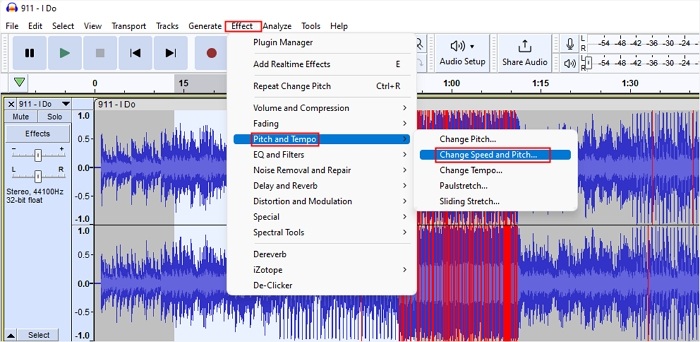
- Speed Multiplier: This controls how fast or slow the audio plays. For instance, setting it to "2.000" doubles the speed (and pitch), while "0.500" halves the speed (and pitch).
- Percent Change: Enter the desired speed change percentage or adjust it using the slider. Permissible values range from -99.000% (1/100th of original speed) to 4900.000% (50 times faster).
- Standard Vinyl rpm: To correct a recording played at the wrong speed, use the two dropdown menus. Select the playback speed in the "From" dropdown and the intended speed in the "To" dropdown.

Step 3. Review and Export.
Click "Preview," and you can hear the result and make reasonable changes as needed. Then, apply the changes and export the audio file.
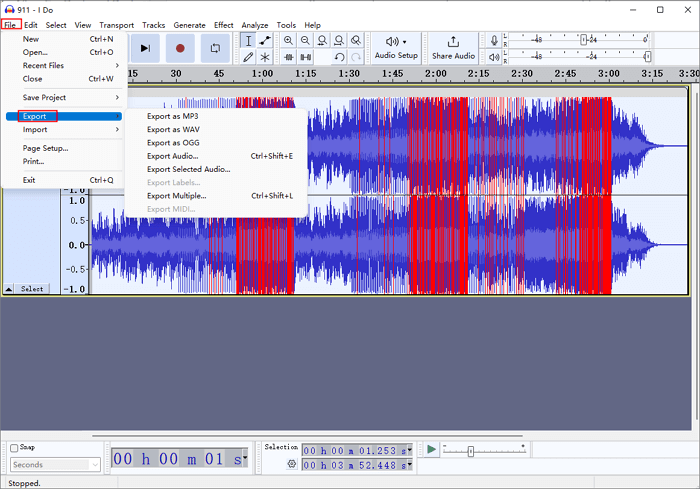
See also:
Increase Volume in AudacityClean up Audio in AudacityHow to Remove Vocals from a Song in AudacityBest Audacity Plugins
3. GSnap Plugin: Without Distortion
Alternatively, you can use a VST autotune plugin to correct the pitch. GSnap is a free pitch-correction auto-tune effect for music production, broadcasting, and audio editing. Use subtle settings to correct vocals or extreme adjustments for T-Pain or Cher effects. MIDI control mode allows recordings to fit new melodies, enhancing creative possibilities.
Autotune Audacity pitch:
Step 1. Download and Add the Plugin.
Download the plugin from https://www.gvst.co.uk/gsnap.htm?pageview=selectos, unzip it, and you'll see the dll file. Right-click this PC and create a new window to find the Audacity > "Plug-ins" folder and drag the file to the folder.
Open Audacity, click "Effect" > "Plugin Manager" > "Rescan," find the filter and enable it. Restart Audacity, upload or record audio, and find GSnap from "Effect."
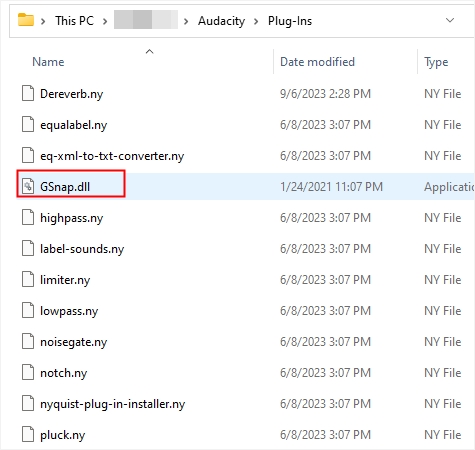
Step 2. Use the GSnap Plugin.
The GUI presents 12 knobs that manage all plug-in parameters, each labeled above with its function and featuring an editable readout below. Next to the pitch data view, twelve switches correspond to the semitones of a full octave, supplementing GSnap's "fixed" mode.
Two additional switches toggle between "fixed" or "midi" modes. The keyboard on the left is where you can select which notes you want.
Detection fine-tunes GSnap's response to incoming audio, while Correction determines the tuning algorithm's method and effect. MIDI controls manage GSnap's handling of specific MIDI information.

Step 3. Listen and Save.
Once you are happy with the settings, click "Apply," play the recording and export it.
Share the article to help others achieve the same seamless results!
Change Song Pitch Online for Free
The above method is quite complicated. Using a simple online pitch changer, you can alter the pitch of audio files without these complex steps.
EaseUS online pitch changer is an easy, free, web-based audio editing program. It allows users to change the music pitch and volume of a song online at the same time, remove vocals from a song, and extract instruments and noise from both audio/video files. Also, it is a key finder for you to locate the BPM, key, and Camelot of a song.
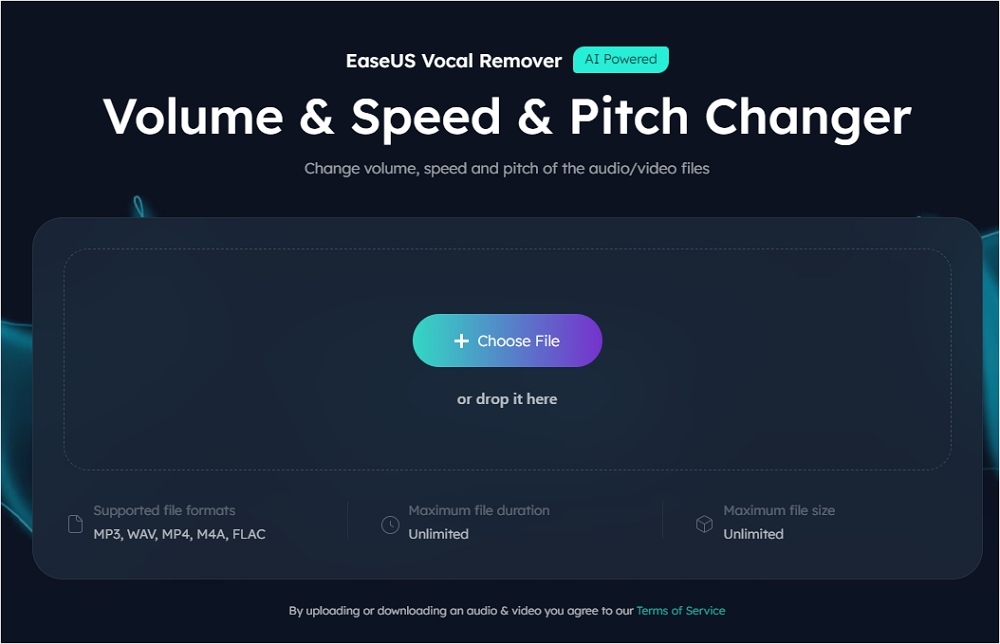
Key Features
- Remove vocals, noise, and instruments from a song.
- Remove background music in videos and recordings.
- Make acapella out of a song.
- Find the key of a song.
- Support multiple file formats.
- Change pitch and volume.
Access it now:
How to change the pitch online:
Step 1. Go to the official site of EaseUS Vocal Remover. Find the "Pitch Changer" from the left sidebar.
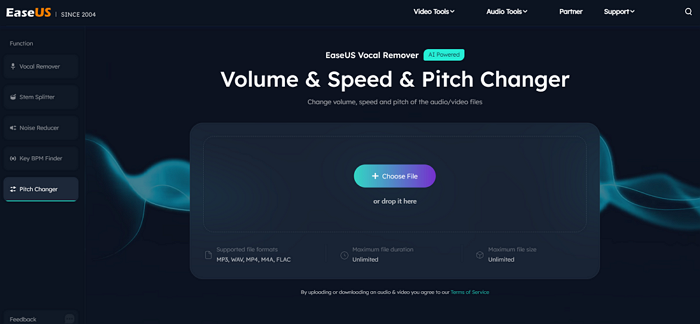
Step 2. Click "Choose File" in the center of the main page. Now, choose the music or video file that you want to change pitch. The AI tool will begin to analysis and show you the BPM and Key as the pic shows below.
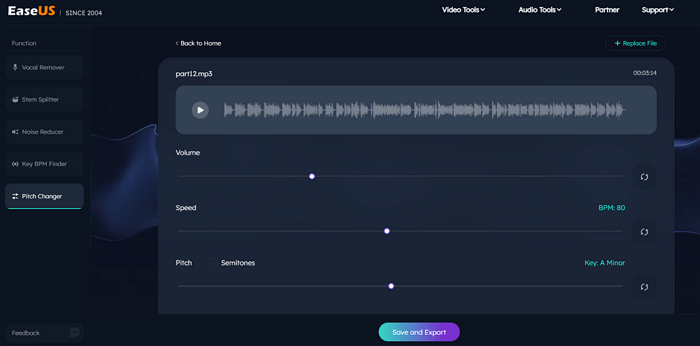
Step 3. Now, modify the pitch with the small dot to the key you want. After that, click "Save and Export" to save to the local file location.
Wrapping up
In conclusion, mastering the art of pitch adjustment in Audacity offers a versatile toolkit for enhancing audio projects without sacrificing quality. By exploring the three methods outlined, users can confidently manipulate pitch while maintaining fidelity and clarity.
However, for those seeking a more streamlined approach, tools like EaseUS Online Pitch Changer provide a convenient alternative, simplifying the process of altering pitch with ease.
Audacity Pitch Change FAQs
1. Can I change pitch in Audacity?
Yes, in Audacity, you can adjust the pitch of audio using various methods available in the "Effect" menu. You can also change the pitch indirectly by altering the speed of the audio clip. Speeding up the track typically raises the pitch, while slowing it down lowers the pitch.
2. How to do pitch correction in Audacity?
To autotune pitch in Audacity, download the free GSnap VST plugin, drag the dll file into the Audacity plugin folder, then add the effect and restart Audacity to activate it. Select the clip and apply GSnap effect, now you can adjust the detection and correction knobs to correct the pitch.
3. How do I change the pitch of an audio file?
You can change the pitch of an audio file without losing quality using the EaseUS pitch changer:
- Access the website and upload the audio file to the "Pitch Changer" tab.
- Toggle the pitch slider left or right to change it.
- Play the song and download the final result.
4. How do you change the pitch of a song?
To change the pitch of a song, you can use various software for audio editing and manipulation.
- Select an audio editing software that supports pitch adjustment, like Audition, GarageBand, etc.
- Import the song to the software.
- Change the pitch using related options.
- Preview and fine-tune the audio.
- Save the modified song.
